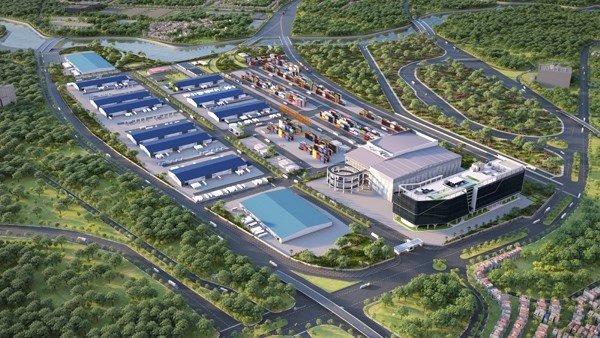More green property trends incoming
A feasibility study contract was signed at the end of last month by MTBS and the investor of a superport in northern Vinh Phuc province, 60km from Hanoi.
Construction began last December for the Vinh Phuc Inland Container Depot Logistics Cente, to be known as Vietnam SuperPort. It is funded by YCH Group, a Singaporean integrated end-to-end supply chain management and logistics partner, and Vietnamese conglomerate T&T Group.
 |
| A graphic design of the Vinh Phuc ICD Logistics Centre (Source: vietnamnet.vn) |
The $200 million, 83-hectare land plot with a designed cargo capacity of about 850,000 TEU will be finished before 2025. According to YCH Group, the SuperPort project will adopt technological advancements such as AI and automation that will help future-proof the logistics industry and enable the delivery of a more integrated, faster, safer, and more sustainable supply chain.
Over the past 20 years, Singaporean developers have also entered Vietnam to build hundreds of apartments and office projects for rent. Typical names include Mapletree, CapitaLand, Frasers Property, Sembcorp Development, and Keppel Land.
Vietnam-Singapore Industrial Park (VSIP) is a joint venture between Sembcorp Development (Singapore) and Becamex IDC (Vietnam). Established in 1996, VSIP has had about a dozen investment projects in IPs spread throughout Vietnam’s provinces and cities, including Binh Duong, Binh Dinh, Nghe An, Hai Duong, Haiphong, and Bac Ninh.
In March, the 1,000ha VSIP3 IP in Binh Duong province started construction. The venture is considered a new milestone for the joint venture because it is designed foremost in a green and sustainable orientation. VSIP3 is designed to integrate smart technology in its operations, from the use of energy, water, and waste to traffic management and security.
Phase 1 of the project is 100ha in size and has met the conditions to be granted the Green Mark Certificate (GMC) of the Construction Authority of Singapore for industrial zones. This will help VSIP III become one of the greenest and most sustainable working environments in Vietnam.
According to chairman of the Board at Becamex IDC Corporation Nguyen Van Hung, so far more than 30 domestic and foreign corporations and companies have shown interest in exploring the possibility of production development at VSIP3, equivalent to around 180ha of land and $1.8 billion in investment capital.
“We will develop this into one of the smartest, greenest, and most sustainable IPs in the country with large capacity solar power plants, providing on-site renewable energy sources for factories and contribution to the zero carbon strategy,” said Hung.
In the Vietnamese real estate market, there are a number of other green building certification systems being utilised besides the GMC that is helping evaluate the performance of buildings in terms of energy use, emissions, design, safety, and working environment.
In Ho Chi Minh City, some office buildings that have been assessed for LEED certification include Deutsches Haus, Friendship Tower, President’s Place, Phu My Hung Tower, and Saigon Center 2, all located in District 1.
In Hanoi, some prime examples include Techcombank Tower, Capital Place, and Landcaster Luminaire.
Elsewhere, CapitaLand Development (Vietnam), the development arm of CapitaLand Group, has won many awards in green and sustainable development for their projects in Vietnam with environmentally-conscious designs. Its incoming $1 billion industrial, logistics, and township development in Bac Giang province is also designed to be green-certified with plans to obtain a LEED certification by the US Green Building Council.
Frasers Property Vietnam, another Singaporean developer, has also outlined its approach moving toward responsible sourcing, with all suppliers using publicly-vetted green building materials. Binh Duong Industrial Park, which Frasers has developed, is on track to achieve LEED certification, while Melinh Point has become the first existing non-residential building in Vietnam to achieve the prestigious Green Mark Platinum Certification awarded by Singapore’s Building and Construction Authority.
According to figures released by the Ministry of Construction earlier this year, the number of green buildings in Vietnam has now reached just over 200, a modest number compared with the number of total projects built and put into operation. The construction and real estate sectors are responsible for nearly 40 per cent of global CO2 emissions and account for about 36 per cent of total energy consumption compared to other sectors.
What the stars mean:
★ Poor ★ ★ Promising ★★★ Good ★★★★ Very good ★★★★★ Exceptional
 Tag:
Tag:
Related Contents
Latest News
More News
- Why Vietnam must build a global strategy for its construction industry (December 31, 2025 | 18:57)
- Housing operations must be effective (December 29, 2025 | 10:00)
- Developers that optimise costs will win out in green transition (December 29, 2025 | 09:37)
- Vietnam charts path to mature smart cities with AI at the core (December 26, 2025 | 16:10)
- Three-way partnership unveiled to ease financing at Hong Hac City (December 24, 2025 | 14:13)
- JustCo expands business into Vietnam (December 22, 2025 | 17:58)
- Sun Group breaks ground on $2 billion Van Don casino complex (December 19, 2025 | 18:14)
- Rare, beautiful, sustainable: the mark of iconic real estate (December 19, 2025 | 08:00)
- Owner-occupied housing stabilises, paving the way for new growth cycle (December 18, 2025 | 17:04)
- Unlocking urban potential of smart cities (December 18, 2025 | 16:50)























 Mobile Version
Mobile Version